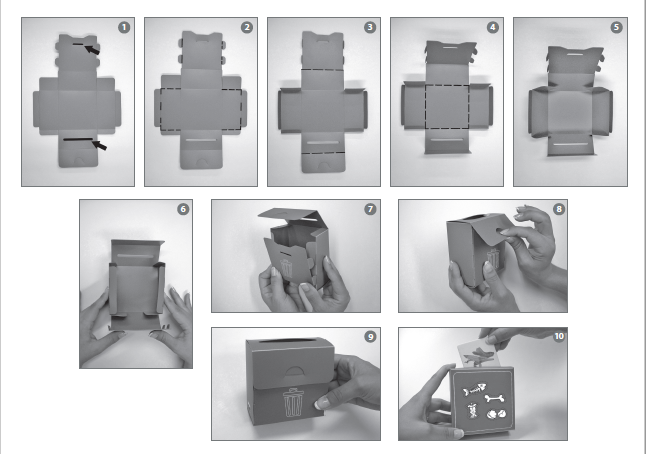€26.00
A game of association for learning to separate and classify different kinds of rubbish: organic, plastic, bottles, cans, paper, cardboard, glass, batteries, etc.
 What do I learn?
What do I learn?In stock
CONTENT
RECOMMENDED AGE
From 3 years and above.
It is not recommended for use without adult supervision for children under 3 years of age.
TEACHING OBJECTIVES
Association Game to learn to separate and sort household waste into containers according to type to facilitate the selection and recycling process. It develops the following teaching subjects:
GAME SYSTEM AND USAGE RECOMMENDATIONS
Before using the material, the teacher must assemble the plastic containers following the instructions of the attached drawing and stick to each of them the sticker of the residue according to the color of the container. Depending on the space it is possible to vary the color of the container and the various residues that can be thrown into it, for this reason the teacher must be informed and decide how to distribute the stickers in the containers.
The game is: The insertion from a slot, present in each container, of the tabs on which are depicted the residues corresponding to the sticker(s) stuck to it.
ACTIVITIES
-Show them each photo saying the name of the waste that is depicted in it: eggshell, fruit peels, newspapers, cookie boxes, soft drink boxes, milk cartons, water packages, glass bottles, batteries, etc.
-Distribute the pictures to the students so that everyone can say the name of the residue they have.
-Organic residues: residues of fruits, vegetables, meat, fish, eggs, etc.
-Paper: bags, newspapers, magazines, etc.
-Plastic packaging: bags, water bottles, packaging for cleaning products, yogurt, food, etc.
-Metal packaging:: cans, soft drinks cans, etc.
– Cardboard packaging for liquids
-Glass: glass containers, bottles, etc.
-Batteries
-Explain what types of selective garbage collection containers are available.
-Explain what kind of garbage should be placed in each container (according to their color)
-Look at the stickers on the containers and explain what type of waste each corresponds to.
-Place labels on each container according to the type of waste to be placed.
-Distribute the photos so that they drop them into the respective containers.
-Place the adhesive circles on the 6 faces of the die.
-Place the waste pictures face up and distribute them among the players.
-The first player rolls the dice. Depending on the color that comes out, choose from among your scrap cards, a scrap that you can put in that color’s container by looking at the sticker on it.
-Then the next player continues and the first player to run out of waste cards wins!

| Weight | 1 kg |
|---|---|
| Dimensions | 30 × 30 × 30 cm |
| Age | 36+ months. Age is indicative, use depends on the child's development |
Real gardening tools for children to learn by playing and to get acquainted with nature.
In stock
With this material, children learn, in a simple way, to open and close buckles.
In stock
Explore the imaginary world of insects, see what changes take place during their lifetime, discover the “aliens” who live under our noses.
In stock
Areas of application for this Montessori material:
In stock
When a young lady or a gentleman decides to enter the world of savoir vivre, it is worth getting our placemat.
In stock
The game comprises 42 cards of thick, robust, very hard-wearing, high quality cardboard, plus 1 maxi-dice made from recycled plastic.
There are six round cards, each showing an enlarged continent, and 36 cards with real-life images showing the landscapes, traditions, foods, wildlife and culture typical of each continent.
The cardboard used is environmentally-friendly and sourced from sustainable forests. It contains a high percentage of recycled material and is 100% recyclable.
In stock
Happiness is made of wood!
In stock
Οι χάρτες παζλ του κόσμου επιτρέπουν στο παιδί να δει, να κρατήσει και να ανιχνεύσει τμήματα του κόσμου προκειμένου να αναγνωρίσει κάθε ήπειρο, χώρα και ο,τιδήποτε αναπαρίσταται στα παζλ.
In stock
In stock
In stock
A game for describing emotions is the first step to starting to develop an emotional conscience, achieving greater self-control and managing to regulate emotions properly.
It helps to identify our own individual emotions, recognize them in other people, and take decisions about our behaviour.
 What do I learn?
What do I learn?Out of stock
Made of high quality wood, this Montessori material is used as a puzzle.
The child learns the parts that make up a bird.
The individual parts only fit into the place provided for them.
You can use the material, amongst other things, to name the individual parts. You can also draw their outlines on a piece of paper and color them.
In stock


Not a member? Create an account
Already got an account? Sign in here